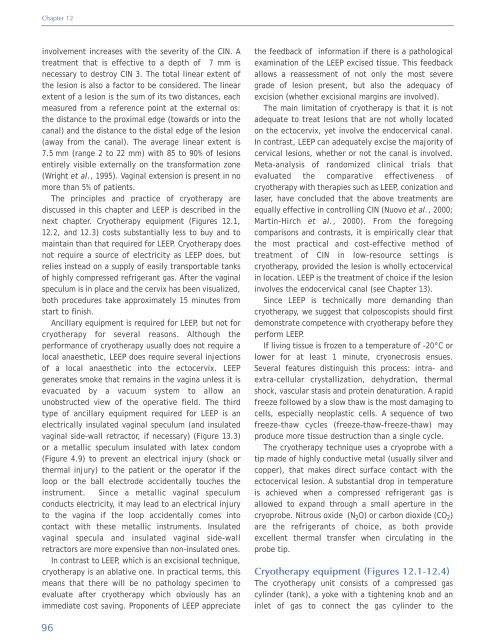Colposcopy and Treatment of Cervical Intraepithelial Neoplasia - RHO
Colposcopy and Treatment of Cervical Intraepithelial Neoplasia - RHO
Colposcopy and Treatment of Cervical Intraepithelial Neoplasia - RHO
Create successful ePaper yourself
Turn your PDF publications into a flip-book with our unique Google optimized e-Paper software.
Chapter 12<br />
involvement increases with the severity <strong>of</strong> the CIN. A<br />
treatment that is effective to a depth <strong>of</strong> 7 mm is<br />
necessary to destroy CIN 3. The total linear extent <strong>of</strong><br />
the lesion is also a factor to be considered. The linear<br />
extent <strong>of</strong> a lesion is the sum <strong>of</strong> its two distances, each<br />
measured from a reference point at the external os:<br />
the distance to the proximal edge (towards or into the<br />
canal) <strong>and</strong> the distance to the distal edge <strong>of</strong> the lesion<br />
(away from the canal). The average linear extent is<br />
7.5 mm (range 2 to 22 mm) with 85 to 90% <strong>of</strong> lesions<br />
entirely visible externally on the transformation zone<br />
(Wright et al., 1995). Vaginal extension is present in no<br />
more than 5% <strong>of</strong> patients.<br />
The principles <strong>and</strong> practice <strong>of</strong> cryotherapy are<br />
discussed in this chapter <strong>and</strong> LEEP is described in the<br />
next chapter. Cryotherapy equipment (Figures 12.1,<br />
12.2, <strong>and</strong> 12.3) costs substantially less to buy <strong>and</strong> to<br />
maintain than that required for LEEP. Cryotherapy does<br />
not require a source <strong>of</strong> electricity as LEEP does, but<br />
relies instead on a supply <strong>of</strong> easily transportable tanks<br />
<strong>of</strong> highly compressed refrigerant gas. After the vaginal<br />
speculum is in place <strong>and</strong> the cervix has been visualized,<br />
both procedures take approximately 15 minutes from<br />
start to finish.<br />
Ancillary equipment is required for LEEP, but not for<br />
cryotherapy for several reasons. Although the<br />
performance <strong>of</strong> cryotherapy usually does not require a<br />
local anaesthetic, LEEP does require several injections<br />
<strong>of</strong> a local anaesthetic into the ectocervix. LEEP<br />
generates smoke that remains in the vagina unless it is<br />
evacuated by a vacuum system to allow an<br />
unobstructed view <strong>of</strong> the operative field. The third<br />
type <strong>of</strong> ancillary equipment required for LEEP is an<br />
electrically insulated vaginal speculum (<strong>and</strong> insulated<br />
vaginal side-wall retractor, if necessary) (Figure 13.3)<br />
or a metallic speculum insulated with latex condom<br />
(Figure 4.9) to prevent an electrical injury (shock or<br />
thermal injury) to the patient or the operator if the<br />
loop or the ball electrode accidentally touches the<br />
instrument. Since a metallic vaginal speculum<br />
conducts electricity, it may lead to an electrical injury<br />
to the vagina if the loop accidentally comes into<br />
contact with these metallic instruments. Insulated<br />
vaginal specula <strong>and</strong> insulated vaginal side-wall<br />
retractors are more expensive than non-insulated ones.<br />
In contrast to LEEP, which is an excisional technique,<br />
cryotherapy is an ablative one. In practical terms, this<br />
means that there will be no pathology specimen to<br />
evaluate after cryotherapy which obviously has an<br />
immediate cost saving. Proponents <strong>of</strong> LEEP appreciate<br />
the feedback <strong>of</strong> information if there is a pathological<br />
examination <strong>of</strong> the LEEP excised tissue. This feedback<br />
allows a reassessment <strong>of</strong> not only the most severe<br />
grade <strong>of</strong> lesion present, but also the adequacy <strong>of</strong><br />
excision (whether excisional margins are involved).<br />
The main limitation <strong>of</strong> cryotherapy is that it is not<br />
adequate to treat lesions that are not wholly located<br />
on the ectocervix, yet involve the endocervical canal.<br />
In contrast, LEEP can adequately excise the majority <strong>of</strong><br />
cervical lesions, whether or not the canal is involved.<br />
Meta-analysis <strong>of</strong> r<strong>and</strong>omized clinical trials that<br />
evaluated the comparative effectiveness <strong>of</strong><br />
cryotherapy with therapies such as LEEP, conization <strong>and</strong><br />
laser, have concluded that the above treatments are<br />
equally effective in controlling CIN (Nuovo et al., 2000;<br />
Martin-Hirch et al., 2000). From the foregoing<br />
comparisons <strong>and</strong> contrasts, it is empirically clear that<br />
the most practical <strong>and</strong> cost-effective method <strong>of</strong><br />
treatment <strong>of</strong> CIN in low-resource settings is<br />
cryotherapy, provided the lesion is wholly ectocervical<br />
in location. LEEP is the treatment <strong>of</strong> choice if the lesion<br />
involves the endocervical canal (see Chapter 13).<br />
Since LEEP is technically more dem<strong>and</strong>ing than<br />
cryotherapy, we suggest that colposcopists should first<br />
demonstrate competence with cryotherapy before they<br />
perform LEEP.<br />
If living tissue is frozen to a temperature <strong>of</strong> -20°C or<br />
lower for at least 1 minute, cryonecrosis ensues.<br />
Several features distinguish this process: intra- <strong>and</strong><br />
extra-cellular crystallization, dehydration, thermal<br />
shock, vascular stasis <strong>and</strong> protein denaturation. A rapid<br />
freeze followed by a slow thaw is the most damaging to<br />
cells, especially neoplastic cells. A sequence <strong>of</strong> two<br />
freeze-thaw cycles (freeze-thaw-freeze-thaw) may<br />
produce more tissue destruction than a single cycle.<br />
The cryotherapy technique uses a cryoprobe with a<br />
tip made <strong>of</strong> highly conductive metal (usually silver <strong>and</strong><br />
copper), that makes direct surface contact with the<br />
ectocervical lesion. A substantial drop in temperature<br />
is achieved when a compressed refrigerant gas is<br />
allowed to exp<strong>and</strong> through a small aperture in the<br />
cryoprobe. Nitrous oxide (N 2 O) or carbon dioxide (CO 2 )<br />
are the refrigerants <strong>of</strong> choice, as both provide<br />
excellent thermal transfer when circulating in the<br />
probe tip.<br />
Cryotherapy equipment (Figures 12.1-12.4)<br />
The cryotherapy unit consists <strong>of</strong> a compressed gas<br />
cylinder (tank), a yoke with a tightening knob <strong>and</strong> an<br />
inlet <strong>of</strong> gas to connect the gas cylinder to the<br />
96
















